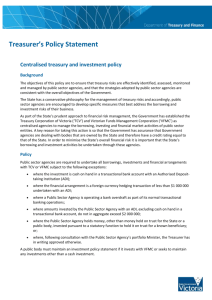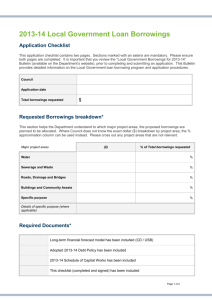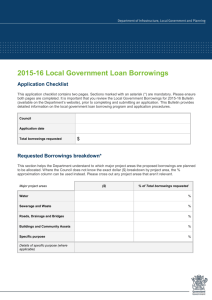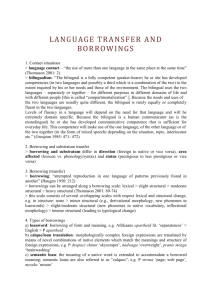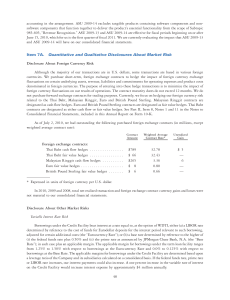treasury & cash investment policy
advertisement
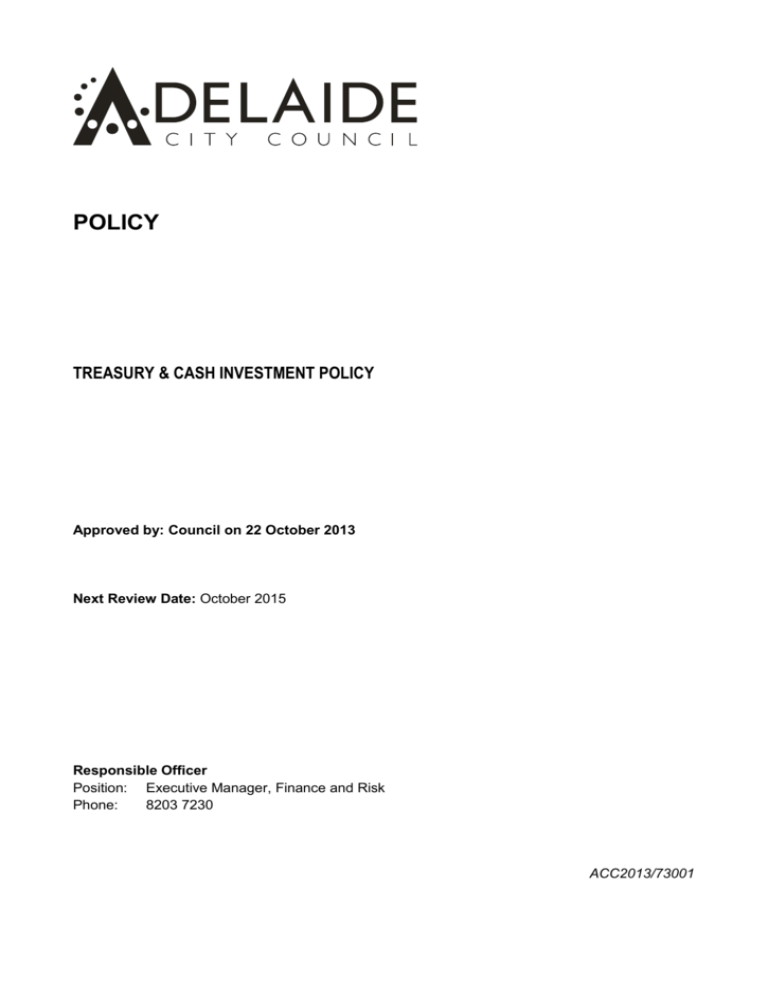
POLICY TREASURY & CASH INVESTMENT POLICY Approved by: Council on 22 October 2013 Next Review Date: October 2015 Responsible Officer Position: Executive Manager, Finance and Risk Phone: 8203 7230 ACC2013/73001 CONTENT 1. INTRODUCTION 2. DEFINITIONS 3. THE ROLE OF TREASURY 4. POLICY OBJECTIVES 5. POLICY STATEMENTS 6. AUTHORISED ARRANGEMENTS 7. REPORTING REQUIREMENTS Page 2 of 13 1. INTRODUCTION This policy: Establishes the principles upon which Council manages financial risk; Underpins Council’s funding and investment decision making; Applies to Council, Management and Staff; and Outlines the management tools to be utilised to monitor Council’s ongoing financial sustainability. 1.1. What is covered by this Policy The Treasury function is responsible for the management of the following financial risks of Council: liquidity and borrowings risk; investment risk; interest rate risk; foreign currency risk; and credit risk; and Operational risk, arising from the management of financial risk, is implicitly addressed through the Treasury Policy. The management of operational risk includes appropriate segregation of duties, maintenance of accurate records, reconciliation of key accounts, and monitoring of financial risk management activities by senior management and Council. 1.2. Policy Approval and Application This document is approved by Council and no part of the document may be amended without Council approval. The approved document includes the body of the document and any explanatory documents. The policy is to be reviewed and approved by Council on a biannual basis. The policy is applicable to the whole organisation including any wholly owned subsidiaries. 1.3. Policy Consolidation For administrative efficiency, this entire Policy may be consolidated within an over-arching Financial Management Policy. This may require some or all sub-sections of the policy to be re-numbered. 1.4. Accounting Policy The recognition and measurement of all financial instruments will comply with Australian Accounting Standard AASB 139 Financial Instruments: Recognition and Measurement. Page 3 of 13 2. DEFINITIONS Amount Available for Projects: Surplus operating income after meeting operating expenditure. Asset Test Ratio: The percentage of total borrowings to Council’s saleable property assets. Calculated as: Total Borrowings / Total Saleable Property Assets (‘Saleable Property Assets’ = Total Property Assets LESS Landmark Public Buildings and Park Lands) Borrowing Risk: The risk that Council will not be able to secure borrowed funds when required. Credit Risk: The risk that a counter-party in a transaction with Council will be unable to meet its financial or delivery obligations. Debt Service Coverage Ratio: The number of times Council’s annual ‘Amount Available for Projects’ can service annual debt servicing commitments. Calculated as: Amount Available for Projects / Annual Principal & Interest Payments Foreign Currency Risk: The risk that Council may suffer financial loss (or gain) from variation in the rate of exchange used to convert foreign currency transactions. Interest Rate Risk: The risk that Council may experience financial loss (or gain) from movements in variable interest rates applicable to borrowings and/or cash investments. Inter-Generational Equity: When assessing investment and borrowing decisions, the consideration given for the “generation of rate payers” who will derive the substantive benefits, versus those who will ultimately pay (through Council rates and user charges) for a particular project or investment. Investment Risk: The risk that Council’s cash investment funds are not preserved, and that Council will suffer financial loss as a result of any investment activities. Leverage Test Ratio: Total borrowings expressed as a multiple of the annual ‘Amount Available for Projects’. Calculated as: Total Borrowings / Amount Available for Projects Liquidity Risk: The risk that Council will have insufficient funds available to pay creditors and other debts when they fall due. Page 4 of 13 3. THE ROLE OF TREASURY This policy has been prepared based on the following principles: There are a broad range of financial and commercial risks which need to be managed centrally by the Treasury function; Cash is a Council asset, to be used for maximum value across Council; ‘User pays’ and inter-generational equity principles are to be considered in determining the most appropriate method of funding Council activities; Council’s ‘risk appetite’ must be considered in managing all financial risks; Speculative transactions that will put Council assets at risk are not permitted; and The Treasury function operates as a service centre, and does not seek to make a profit. Treasury operations, including borrowings, shall be considered an enabler to assist achievement of the strategic objectives of the Council. The Treasury function will manage all financial risks centrally. The operating activities of the Treasury function include: development and recommendation of Treasury strategies; negotiating funding from financial institutions and the capital markets and ensuring there is sufficient liquidity for day to day requirements and contingency for unexpected business disruptions; central management of Council’s liquidity, including surplus cash and short-term borrowing and deposit facilities; central management of interest rate risk associated with borrowings and investment of surplus funds; central management of foreign exchange risks associated with international transactions; management of Council’s transactional bank account requirements; and management of credit and operational risks arising from Treasury activities. Page 5 of 13 4. POLICY OBJECTIVES Council’s financial risks are to be managed centrally to ensure alignment of financial risk management with Council objectives, optimise access to debt capital and ensure that Treasury operates within a controlled environment. The objectives relating to the management of financial risks are as follows. 4.1 Liquidity Risk and Borrowings Ensure that at all times Council has access to sufficient cash resources to meet its financial obligations as they fall due, and provide funds for capital expenditure and investment opportunities as they arise; Ensure that Council has sufficient liquidity to ensure it can meet its non-discretionary financial obligations in the event of unexpected business disruption / natural disasters; Ensure compliance with borrowing facilities covenants and undertakings; Ensure, where possible, that the structure of the borrowing is appropriate for the nature of the asset being funded; Consider ‘user pays’ and inter-generational equity principles in determining the most appropriate way to fund activities; and Ensure Council’s funding activities are in accordance with its legislative and common law responsibilities. 4.2 Cash Investment Risks Ensure that Council funds are preserved; Ensure transactions are not speculative in nature; Ensure Council optimises the return on surplus funds within prudent risk limits, taking into account Council’s ‘risk appetite’; and Ensure Council funds are invested in accordance with its legislative responsibilities under the Local Government Act 1999, and common law responsibilities. 4.3 Interest Rate Risks Minimise net interest costs on borrowings on average over the longer term; Ensure transactions are not speculative in nature; Ensure compliance with interest coverage and other financial covenants, where applicable, under Council’s borrowing facilities; Minimise the impact of adverse interest rate movements. Page 6 of 13 4.4 Foreign Currency Risk Manage the impact of any adverse foreign exchange rate movements on net transaction exposures to ensure (where applicable): the achievement of budgeted results; to protect the predicted financial outcomes of large transactions or capital expenditure proposals; and to protect the cash flows of Council. Ensure transactions are not speculative in nature. 4.5 Credit Risks Ensure that borrowing and investment transactions are undertaken with approved creditworthy counterparties and in accordance with approved limits; and Support Council’s Procurement and Contract Management function to minimise the risk of contract default by key suppliers. Page 7 of 13 5. POLICY STATEMENTS 5.1 Liquidity Risk and Borrowings 5.1.1 Liquidity Measurement Liquidity risk is measured by comparing projected net debt levels for the next twelve months against total committed facilities. Projected net debt levels will take the following into account: existing debt; operating cash flows including interest payments; operating expenditure on capital assets to maintain their operable condition; and project and capital expenditure, which Council has committed through its adopted Business Plan & Budget. Projected cumulative cash flows and net debt levels are to be regularly reviewed, to optimise the timing of draw-down from Council’s committed borrowing facilities. 5.1.2 Liquidity Management Council’s bank account balance is to be kept at a level no greater than is required to meet immediate working capital requirements. Any surplus funds are to be applied to reduce debt, or invested to generate interest income. While Council manages its finances holistically in accordance with its overall financial sustainability strategies and targets, it is not prevented from: Borrowing funds for major infrastructure projects (e.g. projects ≥ $10 million); Borrowing funds for revenue-generating investments (supported by a robust business case); or Retaining or quarantining funds for particular purposes. 5.1.3 Borrowing Requirements Council’s net borrowing requirements will be reviewed annually as part of the Business Plan & Budget development and update of the Long Term Financial Plan. 5.1.4 Level of Borrowing The level of overall borrowing that Council can sustain will take into account the following: strategic planning for the future of the Council, covering short, medium and long term spending and investment requirements; current and estimated future revenues and the ability to increase the revenue stream through rates growth, user charges, additional grant funds or business activities; opportunities to leverage external grant funding for non-revenue generating projects; inter-generational equity considerations in terms of the rate payers who benefit from the expenditure and therefore, on a user pays basis, who should pay for the costs associated with such expenditure; current and future funding needs for both operating and capital expenditures; and Page 8 of 13 the ‘risk appetite’ of Council, as defined by Council’s prudential limits, in accordance with the following indicators: Debt Service Coverage Ratio = Leverage Test = The Asset Test = Minimum: 5 times Maximum: 1.5 years Maximum: 25% These ratios are to be included in the Annual Business Plan & Budget document adopted by Council. 5.1.5 Structure of Borrowings Borrowings may be structured as a mixture of short and long-term, fixed and floating interest rates. Borrowings for revenue-generating investments should match the business case assumptions. For administrative efficiency, surplus cash or short-term borrowings may be utilised during the construction phase of major projects, consistent with a holistic approach to cash management. 5.1.6 Repayment of Borrowings The term of borrowings should match the need for funds. Short-term borrowings (less than one year) may be used to manage seasonal cash flow fluctuations. Longer-term borrowings may be used for new infrastructure or property assets. Unless otherwise specified by Council: Borrowings <$10 million will have a re-payment timeframe of 6 years (based on 1½ Council terms); Borrowings ≥$10 million will have a re-payment timeframe of 10-15 years; All borrowing terms are to be structured with Principal and Interest repayments, unless otherwise approved by Council; and Borrowings for revenue-generating investments should match the business case assumptions. 5.1.7 Borrowing Risk Management To manage the risk associated with Borrowings: Council approval is required for all new loans, as per Section 44 (3)(c) of the Local Government Act 1999; Loans are to be provided by institutions with long term Standard and Poors (or equivalent) credit ratings of ‘A’ (Authorised Borrowing Institutions) or better; All new loans are to be tendered to at least three Authorised Borrowing Institutions. Page 9 of 13 5.2 Cash Investment Risk 5.2.1 Cash Investment Policy Funds that are not immediately required for operational needs, and cannot be applied to either reduce existing borrowings or avoid the raising of new borrowings, will be invested. Without further approval from Council, cash investments are limited to ‘approved investments’, including: Deposits with the Local Government Finance Authority; Bank accepted / endorsed bank bills; Bank negotiable Certificate of Deposits; Bank interest bearing deposits; and State / Commonwealth Government Bonds. Cash investments must not be speculative in nature. 5.2.2 Cash Investment Spread Treasury may invest: 100% of investments with ‘A1’ rated (Standard and Poors, or equivalent) organisations; but No more than $20,000,000 invested with any individual ‘A1’ rated organisation. 5.3 Interest Rate Risk To manage Interest Rate risk, Treasury will: Manage its borrowings and investments to minimise net interest costs on average over the longer term; Aim to have a variety of maturity dates on its fixed interest rate borrowings, in order to spread its exposure to interest rate movements; and Ensure there is an appropriate mix of fixed and variable interest rate borrowings, which enable flexibility in the amount of principal to be repaid or redrawn at call. Page 10 of 13 5.4 Foreign Currency Risk Potential sources of Council’s foreign currency exposure include: purchases of goods and services in a foreign currency; and purchases of capital equipment priced in foreign currency, or subject to price change due to relative movements in exchange rates. Foreign currency hedges (in the form of forward exchange contracts) may be used to mitigate the risks of significant adverse currency movements, but must not be speculative in nature. Foreign exchange options and other derivative instruments will not be used. The Procurement function should notify Treasury as soon as any potential foreign currency exposures are identified. Foreign currency exposures in excess of AUD 100,000 must be hedged. Hedges will be taken out with institutions holding a minimum rating of ‘A1’ per Standard & Poors (or equivalent). Treasury must obtain quotes from at least two different financial institutions, to ensure best value is achieved. 5.5 Credit Risk Credit risk may arise from financial institutions with whom Council has borrowings or cash deposits, customers and members of the public who have a financial liability to Council, or suppliers contracted to deliver a service or project. To mitigate avoidable credit risks: Borrowings and cash deposits will only be held with financial institutions with long-term Standard & Poor’s (or equivalent) credit ratings of ‘A’ or better; Where required by Procurement Policy, key suppliers will be subject to independent credit assessment (e.g. Dun & Bradstreet report) prior to awarding new contracts; Payments to suppliers in advance of delivery are subject to approval by Council’s Procurement Manager. Page 11 of 13 6. AUTHORISED ARRANGEMENTS 6.1 Approval of Bank Accounts The Treasury function should actively seek to minimise the number of different bank accounts operated by Council or its business entities. Opening and closure of bank accounts may only proceed with written authorisation from the Chief Executive Officer. 6.2 Approval of Borrowing Arrangements All new borrowing arrangements will be approved by Council, as required by Section 44 (3)(c) of the Local Government Act 1999. The power to borrow money cannot be delegated from the Council itself. Council approval of borrowing requirements for the upcoming year is included in the Annual Business Plan & Budget adoption. Details of the effects of the new borrowings on the applicable borrowing ratios are to be provided with the budget documentation, including the trend of these ratios in the Long Term Financial Plan. Page 12 of 13 7. REPORTING REQUIREMENTS 7.1 Overview The objectives of reporting are to: provide information on the financial risk exposures being managed by the Corporation; provide positive assurance concerning compliance with the Treasury Policy; monitor the performance of financial risk management; and enable informed decisions with respect to financial risk management. 7.2 Reporting 7.2.1 Monthly Reporting A monthly Borrowings & Cash Investments Summary will be provided to the Executive Leadership Group outlining the following: for each borrowing and cash investment - the balance of funds, its interest rate and maturity date, and changes in the balance since the previous report; a summary of interest income and expenditure variance from budget for the month and year to date; and a summary of foreign currency exposures, hedges in place at reporting date, and details of any new or executed hedges for the month and year to date. 7.2.2 Quarterly Reporting A quarterly report on borrowing and cash investment performance will be included as part of the quarterly budget review to Council. The report will highlight: for each borrowing and investment - the balance of funds, its interest rate and maturity date, and changes in the balance since the previous report; the proportion of fixed interest rate and variable interest rate borrowings at the end of the reporting period; a summary of interest income and expenditure variance from budget for the quarter and year to date; and a summary of foreign currency exposures, hedges in place at reporting date, and details of any new or executed hedges for the quarter and year to date. Page 13 of 13


